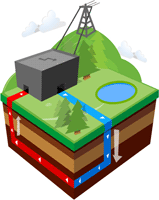
The research documented significant geothermal energy resources across the United States with a potential to produce more than three million megawatts of alternative energy power. This is more than ten times what currently installed coal power plants produce. Furthermore, this energy could be harnessed with existing technology.
The research resulted in sophisticated maps that can be seen with the latest version of Google Earth. The estimated amounts and locations of heat stored in the Earth’s crust included in this study are based on nearly 35,000 data sites – approximately twice the number used for Blackwell and Richards’ 2004 Geothermal Map of North America, leading to improved detail and contouring at a regional level.
The additional data was primarily drawn from oil and gas drilling. Larger local variations can be seen in temperatures at depth, highlighting more detail for potential power sites than was previously evident in the eastern portion of the US. Eastern Virginia, for example, has been identified as part of a larger Appalachian trend of higher heat flow and temperature.
So far US geothermal production using conventional methods has been focused on the western third of the country, in locations such as The Geysers Field north of San Francisco. But new technologies and drilling methods can now be applied to a wider range of geological conditions, allowing reliable production of clean energy at temperatures as low as 100ËšC (212ËšF), and in regions not previously considered suitable for geothermal energy production.
One such case is the geothermal resource sitting under the state of West Virginia, which was revealed by preliminary data released from the SMU study in October 2010. This reserve is equivalent to the state’s existing power supply, which is mostly coal-based.
Other areas of particular geothermal interest include the Appalachian trend (Western Pennsylvania, West Virginia, to northern Louisiana), the aquifer heated area of South Dakota, and the areas of radioactive basement granites beneath sediments such as those found in northern Illinois and northern Louisiana.
The Gulf Coast continues to be outlined as a huge resource area and a promising sedimentary basin for development. The Raton Basin in southeastern Colorado possesses extremely high temperatures and is being evaluated by the State of Colorado along with an area energy company.
You should follow us here.
Enhanced Geothermal Systems (EGS)





